danbricklin.com/log
|
||
|
|
Starting January 3, 2003
Dave Winer's weblogger meeting at Harvard, Trip to Atlanta, UCLA Internet Report (and my cameras), I got my Tablet PC fixed and updated my review, SMBmeta tools available, SMBmeta proposal on new TrellixTech weblog, Halley Suitt lunch, Interland acquisition of Trellix completed, Happy New Year!
03Jan03-12Feb03
2003_01_03.htm
|
|
|
Demo 2003 [link]
I'm writing this flying back from Chris Shipley's Demo 2003 conference that was held in Scottsdale, Arizona. I attended as a speaker on a panel entitled "Making History: The Next Chapter", along with longtime industry participants Mitch Kapor, John Patrick, and Les Vadasz. There have been numerous accounts of the conference, including Dan Gillmor's real-time weblog which includes lots of what was said on our panel, John Patrick's report with a list of most of the demonstrators, and Sandra Gittlen's weblog on Network World Fusion. Here I'll just show a few pictures and make some overall technical comments.
 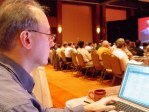 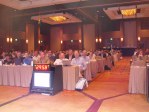 Chris Shipley starting the conference, Dan Gillmor sitting next to me posting to his weblog, view from the stage of half of the 500+ attendees
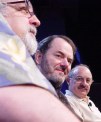 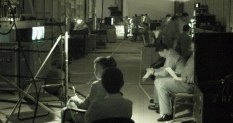 Mitch Kapor, John Patrick, and Les Vadasz photographed with a camera on my lap during our panel, the view backstage before we went on
 The winners of the Demo Gods awards
Some interesting technology ideas: Kubi Software uses XML over SMTP (email) as a platform for building collaborative e-spaces within Outlook and Notes. XML over HTTP has proven to be a phenomenally useful technology for easily building distributed applications and services -- perhaps this will be, too. A couple of companies had devices with antenna arrays that can be electronically aimed to enhance WiFi and other wireless. A couple more used mesh radio to let little, low-power, inexpensive devices (temperature meters, lawn water-content meters) connect up to controllers at a distance by finding nearby devices and hopping the data from device to device. Mok3 abacus was my favorite. It's a PC application that uses photographs as a guide for humans to indicate 3D geometry changes for quickly making photorealistic, texture-mapped 3D models that can be rotated, flown through, etc. I love such good splits between human and computer expertise. The user indicates where a wall hits the floor and ceiling or turns a corner (a type of edge detect and understanding that is hard for a computer), and then the program can figure out the perspective (mathematical transformations that can be hard for a person). It even has a special cloning brush. (A cloning brush is part of most image manipulation programs for copying part of an image from one place to another to cover over blemishes with clearer skin nearby, painting sky over power wires, etc.). This brush "paints" with the right perspective of the new location. (For example, if you clone something up close onto something further away, it paints smaller.) Here it's useful for filling in parts that are obscured by something in front in the photo.
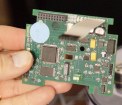 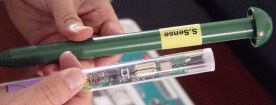 Radio communicating devices that use mesh radio: One for industrial applications and one used in a stake you put in the ground that measures how wet the ground is to turn sprinklers on and off
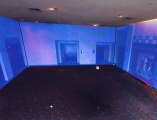 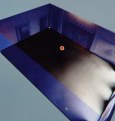 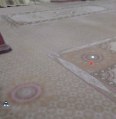 Here you can see three walls selected and highlighted (blue tint) on a photograph in the first image. In the second the room is now rotated in 3D using that information. The last image shows the cloning tool being used to copy part of a rug to another place on the floor
Postscript: As the plane taxied up to the gate, I noticed that despite the 2+ feet of snow that fell this week the airport was strangely devoid of snow. I assumed they picked it up and dumped it into the ocean. Then I saw a pile still left with front end loaders dumping it into a Trecan Snowmelter. (I found the name by looking closely at my pictures when I got home). In goes snow, out goes water. So that's how they do it...
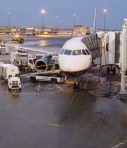 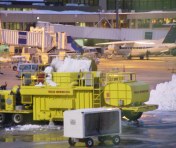  Logan Airport with snow-free tarmac, Snowmelter with snow being dumped into it, closeup taken through airplane window showing water pouring out
Congratulations Pyra! [link]
Pyra, the people who bring us the Blogger system, is being bought by Google. See Dan Gillmor's report. Congratulations Evan and the others who hung in there through thick and thin to get this far. (Pyra's investors included O'Reilly & Associates, Advance Publications, Jerry Michalski, The Accelerator Group, and Michael Sippey according to previous reports.)
We at Trellix played a small part in Pyra's journey, and I'm glad to see that helping them stay alive wasn't in vain for their users nor weblogging in general. When somebody calls for help it isn't always hopeless. And when things look bad, asking for help isn't always counterproductive.
Dave Winer's weblogger meeting at Harvard [link]
Bob Frankston and I drove together to Harvard University last night to attend Dave Winer's weblogger meeting. I took lots of pictures and posted 44 of them on a page here for those who are interested. The meeting was fun, attended by lot of people who cared deeply about the subject. Some drove in from hours away, though most were local. You can read about it in Donna Wentworth's account, as well as Bob Frankston's. I assume Dave will eventually link to any other accounts.
Dave was kind enough to bring up my SMBmeta Initiative, which people seem to really like.
I viewed my role (besides participating) as being to take pictures and let people who haven't attended a "Dave Meeting" see what one looks like. I also used it as a chance to try out my new camera in these situations. (I explained about my new camera on January 31st, below.) My camera's low-light and zoom capabilities didn't disappoint me -- they did just what I wanted. I even got an infrared shot while we were walking through dark Harvard Yard (people didn't stop to pose).
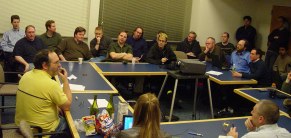  Some of the people in the meeting, Dave walking through Harvard Yard
See "Dave Winer's First Harvard Weblogger Meeting". (Note: There are over 40 pictures on that page, most larger than the ones on this page.)
Trip to Atlanta [link]
I just got back from a trip to Atlanta to be at Interland's offices down there. It's something I have to do as part of my job as CTO of Interland. In addition to meeting with many people (most for the first time), I managed to spend about 2 and a half hours listening in on technical support calls. I think that's a really important way to learn about your customers, your products, and more. Hopefully it will help me when designing new products. Here's a picture of Buzz Kelley, Trellix's Chief Architect and also from our Massachusetts office, listening in like I did:
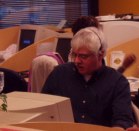 Buzz listening to tech support calls
Interland has two main offices in Atlanta, both of which I spent time in each day. They are about a 15 minute walk apart. On my walks I kept running into some of the Atlanta Ambassador Force people. They are there to help people, answering questions, etc. They have had Segways for about 11 months. I've posted some pictures and comments on a Segways In Atlanta page.
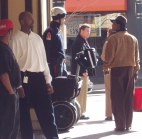 Segway in Atlanta
On this trip, after years and years of anticipation, I finally got to drive through the new direct link from the Massachusetts Turnpike to the airport, thanks to the "Big Dig". In bad traffic (which I didn't get at 4:50 am on the way down, nor 9:30 pm on the way back) it can cut an hour off the trip, which normally now takes less than 20 minutes.
 Entering the new section of I-90 on the way home
This was one of those nice things that happens at just the right time. Just as I need to fly to Atlanta frequently to visit the new headquarters, the ride gets shorter. Something similar happened in the early 1990's when I started at Slate Corporation, which was headquartered in Scottsdale, Arizona. America West started flying non-stops from Boston to Phoenix within days of when I started monthly trips. Sometimes things go right.
UCLA Internet Report (and my cameras) [link]
The UCLA Center for Communications Policy just released their third yearly study of Internet use: The UCLA Internet Report - "Surveying the Digital Future". Another useful set of real data for seeing how the Internet is becoming part of society. This is an 89-page PDF file (but the type is big).
A few things I noticed that interested me [excerpts with emphasis added]:
I think there is some information to explain the rise and value of weblogs that can be gleaned from these excerpts. People will move from television-like entertainment to an information and person-to-person communications medium. People know that not everything is trustworthy on the Internet, but they know how to find what they do trust. Weblogs fit in with this perfectly.
This is yet another posting here on my weblog with no pictures. Bummer. I've always liked sharing what I see and recording it for me to look back at in the future. (At least the report I link to above has lots of graphs...)
I've finally purchased a digital camera that I've had my eye on for a while: a Sony DSC-717. The reason I chose it was to help get pictures for this weblog (as well as at events for family and friends). It is very good in low light (F2.0-2.4 with up to ASA 800, and can even shoot in the dark in a B&W infrared mode that I've used at a party in a movie theater) and has a longer zoom than I've been using previously. This should help with the pictures of speakers and parties that I often post here. I've been throwing out so many blurred pictures because people move during quarter-second exposures. I'm attending (and speaking at) the Demo 2003 conference in a few weeks and I hope to mainly report with pictures.
I also have an Olympus C-50 that I keep with me in my computer bag all the time. It's much smaller than the Sony, which is more the size of a small SLR. I believe strongly in having a camera you can always carry around. Both cameras can take 5 megapixel photos and do a great job on normal bright light or flash shots.
Actually, maybe I will add some pictures. Here are pictures of the two cameras, each taken with the other. I took them in a mirror and then flipped them 180 degrees before placing here. I had to use a flash to handhold the little camera taking the big one, but the sensitivity of the Sony paid off even zoomed in so I didn't need a flash for the big camera taking the little one (though the 800 ASA is quite grainy, but that doesn't show up much on a weblog):
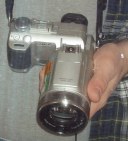 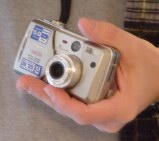 My two digital cameras: a Sony DSC-717 and an Olympus C-50, each taken with the other in a mirror, and each bought for a reason
I got my Tablet PC fixed and updated my review [link]
When I originally wrote about my Toshiba 3505 Tablet PC I complained about the lag between pen motion and screen cursor. I heard from one of the readers of this weblog that this was a common problem with some of the units he knew about. After a few weeks of back and forth with Toshiba, they figured out that it was a problem with some of the early digitizer units and was easily fixable with a simple ROM upgrade (not the system ROM). All I needed to do was bring it in for free warranty repair and get a new digitizer. I did that last week and it is much better now. I've upgraded my review to include what happened and to remove the complaints about the slow pen. The ink now works much more like what I was used to and is quite adequate for notetaking, even for those with "chicken scratch" printing like mine. I've also added a few comments at the end about using the machine as my normal laptop for the last couple of months. See "Tablet PC: First Impressions".
SMBmeta tools available [link]
I put up some tools to help get the SMBmeta initiative going on a new SMBmeta.org web site. These are my second foray into Perl coding, and my first into using mySQL. It's been fun trying to become proficient in a new language. Now comes the embarrassing part: Adding enough comments for people to understand my code and then releasing the source for others to read and try to modify.
There is something I'm learning: One of the great parts of being a weblogger is the community that grows up around what you write. It's really a two-way street. You get emails and read what others say about what you write. It's an ongoing relationship. As Dan Gillmor likes to point out (for example, in his "We Media" article in the Columbia Journalism Review) "...my readers definitely know more than I do, and, to my benefit, they share their knowledge." In software development there has always been the concept of doing beta testing. There have been Requests For Comments. With a weblog and associated files, and the weblogs of readers, doing such testing today, even at a very early stage, can be much more efficient and widespread than it used to be. I can understand how open source can be so effective because it harnesses such a diverse population. I see how the organizing form of a weblog, much like that of one a person on the podium with an audience ready to participate, works so well. In today's world with less privacy, at least we can use such tools to leverage that openness to our advantage in development. Companies that don't learn how to do that will be at a disadvantage.
SMBmeta proposal on new TrellixTech weblog [link]
At my job with Trellix/Interland, we've been thinking about how we can apply what we've learned about web services, RSS, etc., to our products for small businesses. The experimentation with RSS, and the web services from Amazon, Google, and others, got us thinking. What does small business need to provide to others in a computer-to-computer way? One thing led to another, and it dawned on us: There's valuable information, such as location, that a business can provide to others without needing active serving. A semi-static XML file, like RSS, is sufficient. Out of this comes the "SMBmeta File" proposal. (That's "Small and Medium-sized Business metadata" file.)
I've started the TrellixTech.com web site (which has a weblog) to make this proposal and follow it through. It includes an introductory essay and a first draft of a specification. In the coming days and weeks some server-based tools for creating and checking these files, and a database to aid in the initial aggregation, will hopefully be released. Interland has agreed to provide hosting for these services, and much of the source code will be available under an Apache-like license so others can use it as a base for experimentation if they'd like.
Everybody I've talked to about this is very excited. It's a nice, open, distributed, and nonproprietary way to provide better information for customers to find what they want. It leverages off of what the weblog community has been doing -- yet another way in which the weblog community helps move the whole Internet ahead. Rather than being centralized, here's a directory that is written by those that are in it, and compiled by anybody who wants. It just seems ripe as a basis for innovation.
Read the TrellixTech.com material and see what you think.
Halley Suitt lunch [link]
I attended Halley Suitt's "Halley Blog 1-year Anniversary Party" in Harvard Square. (Harvard Square is soon to be Dave Winer's new hangout locale with his upcoming fellowship at Harvard.) I've posted pictures on a "Halley Suitt's Weblog 1-Year Anniversary Lunch" page.
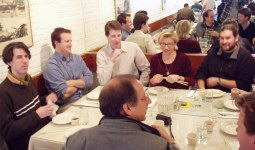 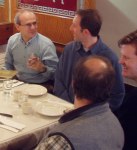 Some of the pictures
Interland acquisition of Trellix completed [link]
Yesterday, after getting all the required paperwork done, there was a Trellix shareholders' meeting to formally approve the merger with Interland. Later in the day Interland did their part and Trellix became a part of Interland. I'm now an employee of Interland. For now, email addresses will stay the same.
We signed the final papers at the offices of our lawyers, Testa, Hurwitz & Thibeault in downtown Boston. When we sold the Software Arts assets to Lotus back on April 5, 1985, the initial deal was signed at the offices of Lotus' lawyer firm -- also Testa Hurwitz (though they've since moved to a new location).
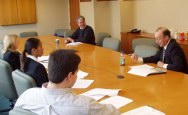  Trellix CEO Don Bulens going through the shareholder meeting script as CFO Denis Liptak and three Testa Hurwitz lawyers look on, a picture from 1985 of the room at Test Hurwitz where we signed the deal between Lotus and Software Arts
Interland is a public company (unlike the old Trellix, which was privately held), so discussions of it here will be simple and brief for now. Bear with me while I work out a style that works.
Happy New Year! [link]
Another year passes, another starts. Let's hope this one brings good things to our industry and to the world in general. Unlike the last few years, the year number, 2003, rings no bells with me. 1999, 2000, 2001, and even 2002 were all "special" numbers in my head with old associations (i.e., the end of the 1900's of my birth, that magic far-distant year we awaited since my childhood, the movie, and my first car). 2003 starts with a clean slate. Let's make the most of it.
|
||
|
© Copyright 1999-2018 by Daniel Bricklin
All Rights Reserved.
|
||